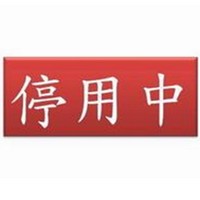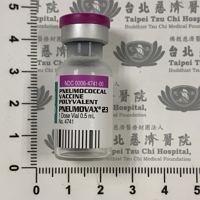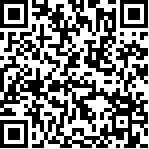藥品名稱
drug name | Pneumococcal Polysaccharide Vaccine 25 mcg/0.5 mL/vial (Pneumovax 23) (公費75歲以上老人)紐蒙肺多價性肺炎鏈球菌疫苗 |
| 藥檔狀態 | 停用 |
成 份
Ingredient | Pneumococcal Polysaccharide Vaccine |
| 單位含量 | 25 mcg/0.5 ml/vial |
| Dosage Forms | Injection, solution: 25 mcg each of 23 capsular polysaccharide isolates/0.5 mL (0.5 mL) |
| 外觀描述 | |
| Appearance | |
廠商名稱
Manufacturer | 美商默沙東藥廠股份有限公司台灣分公司 |
製 造 商
Manufacturer | MERCK SHARP & DOHME CORP. |
字 號
Product ID | 衛署菌疫輸字第000492號 |
藥理分類
Pharmacologic Category | Vaccine; Vaccine, Inactivated (Bacterial) |
作用機轉
Mechanism of action | Pneumococcal polysaccharide polyvalent is an inactive bacterial vaccine that induces active immunization to the serotypes contained in the vaccine. Although there are more than 90 known pneumococcal capsular types, pneumococcal disease is mainly caused by only a few serotypes of pneumococci. Pneumococcal vaccine polyvalent contains capsular polysaccharides of 23 pneumococcal types of Streptococcus pneumoniae that represent at least 85% to 90% of pneumococcal disease isolates in the US. The 23 capsular pneumococcal vaccine contains purified capsular polysaccharides of pneumococcal types 1, 2, 3, 4, 5, 6B, 7F, 8, 9N, 9V, 10A, 11A, 12F, 14, 15B, 17F, 18C, 19F, 19A, 20, 22F, 23F, and 33F.
Efficacy: In adults, PPSV23 demonstrated 50% to 80% efficacy in preventing invasive pneumococcal disease due to relevant serotypes of S. pneumoniae(CDC/ACIP 59[34] 2010). |
| 用途/適應症 | |
| Use |
Pneumococcal disease prevention:?Active immunization of children ≧2 years and persons ≧50 years who are at increased risk for pneumococcal disease caused by the 23 serotypes included in the vaccine.
The Advisory Committee on Immunization Practices (ACIP) recommends routine vaccination for patients with the following underlying medical conditions (ACIP [Kobayashi 2015]; CDC/ACIP 59[34] 2010; CDC/ACIP 61[40] 2012; CDC/ACIP [Matanock 2019]; CDC/ACIP [Nuorti 2010]):
Children ≧2 years of age, adolescents, and adults 19 to 64 years?with functional or anatomic asplenia, including sickle cell disease or other hemoglobinopathies, congenital or acquired asplenia, splenic dysfunction, or splenectomy
Immunocompetent children ≧2 years of age and adolescents?with chronic heart disease (particularly cyanotic congenital heart disease and heart failure), chronic lung disease (including asthma if treated with high dose corticosteroids), diabetes, cerebrospinal fluid leaks, or cochlear implants
Immunocompetent adults 19 to 64 years?with chronic heart disease (including heart failure and cardiomyopathies; excluding hypertension), chronic lung disease (including COPD, emphysema, and asthma), diabetes, cerebrospinal fluid leaks, cochlear implants, alcoholism, chronic liver disease, cirrhosis, and cigarette smokers
Immunocompromised children ≧2 years of age, adolescents, and adults 19 to 64 years?with congenital or acquired immunodeficiency (includes B or T cell deficiency, compliment deficiencies and phagocytic disorders; excludes chronic granulomatous disease), HIV infection, chronic renal failure, nephrotic syndrome, leukemia, lymphoma, Hodgkin disease, generalized malignancies, solid organ transplant, multiple myeloma, or other diseases requiring immunosuppressive drugs (including long-term systemic corticosteroids and radiation therapy)
All adults ≧65 years of age
|
衛福部核准適用症狀
MOHW approved indications |
預防肺炎鏈球菌性肺炎及肺炎鏈球菌性菌血症。
|
| 常用劑量 | 0
(藥品劑量會因人或病情增減,請依照醫師指示服用。) |
| Dose |
Adult
Note: Immunization during coronavirus disease 2019 (COVID-19) pandemic: Routine vaccination should not be delayed because of the COVID-19 pandemic (CDC 2020; WHO 2020). In general, simultaneous administration of all vaccines for which a patient is eligible (according to current immunization schedules/guidelines) is recommended (ACIP [Ezeanolue 2020]). However, vaccination of patients with suspected or confirmed COVID-19 infection (regardless of symptoms) should be postponed to avoid exposure to health care personnel and other patients (CDC 2020). Additional information is available from the CDC, the American Academy of Pediatrics, and the Immunization Action Coalition.
●Immunization:?Adults 19 to <65 years with specified underlying medical conditions: IM, SubQ: 0.5 mL as a single dose.?Note:?Some medical conditions do not require pneumococcal conjugate vaccine (PCV13) [see guidelines for details] (ACIP [Kobayashi 2015]):
# Primary vaccination:
Pneumococcal vaccine-naive or vaccination status unknown: Administer PCV13 followed by pneumococcal polysaccharide vaccine (PPSV23) at least 8 weeks later
Previously received PPSV23 but not PCV13: No additional PPSV23 doses needed for primary vaccination; administer PCV13 ≧1 year after the last PPSV23 dose was received
Previously received PCV13 but not PPSV23: Administer PPSV23 at least 8 weeks after PCV13
#Revaccination:?Adults 19 to 64 years with functional or anatomic asplenia, chronic renal failure or nephrotic syndrome, HIV, or who are immunocompromised: One PPSV23 revaccination dose ?5 years after first dose of PPSV23 and ?8 weeks after PCV13.?Note:?If PPSV23 is given before PCV13, the minimum interval is 1 year (ACIP [Kroger 2021]).
Pediatric
Note: Immunization during coronavirus disease 2019 (COVID-19) pandemic: Routine vaccination should not be delayed because of the COVID-19 pandemic (CDC 2020; WHO 2020). In general, simultaneous administration of all vaccines for which a patient is eligible (according to current immunization schedules/guidelines) is recommended (ACIP [Ezeanolue 2020]). However, vaccination of patients with suspected or confirmed COVID-19 infection (regardless of symptoms) should be postponed to avoid exposure to health care personnel and other patients (CDC 2020). Additional information is available from the CDC, the American Academy of Pediatrics, and the Immunization Action Coalition.
Note: Consult CDC/ACIP annual immunization schedules for additional information including specific detailed recommendations for catch-up scenarios and/or care of patients with high-risk conditions. According to ACIP, doses administered ?4 days before minimum interval or age are considered valid; however, local or state mandates may supersede this timeframe (ACIP [Kroger 2021]).
●Primary immunization: Children≧2 years and Adolescents with specified underlying medical conditions: IM, SubQ: 0.5 mL as a single dose; immunization with pneumococcal conjugate vaccine (PCV13) should be completed prior to pneumococcal polysaccharide vaccine (PPSV23) as recommended. The minimum interval between PCV13 and PPSV23 is 8 weeks.
●Revaccination: Children≧2 and Adolescents with functional or anatomic asplenia, those who are immunocompromised, and others with high-risk medical conditions : One revaccination dose ≧5 years after the first dose of PPSV23.
Geriatric
●Immunization:?Adults ?65 years:?IM, SubQ:?0.5 mL as a single dose.?Note:?All patients should receive routine pneumococcal polysaccharide vaccine (PPSV23); receipt of pneumococcal conjugate vaccine (PCV13) is dependent upon specific risk factors and/or shared clinical decision making (CDC/ACIP [Matanock 2019]):
Advisory Committee on Immunization Practices recommendations for timing of administration (CDC/ACIP [Matanock 2019]):
Persons who do not have an immunocompromising condition, cerebrospinal fluid leak, or cochlear implant:
#PPSV23 only:
Pneumococcal vaccine-naive or vaccination status unknown: Administer a single dose of PPSV23 at ?65 years of age.
Previously received PPSV23 at <65 years of age: If a dose of PPSV23 was administered at <65 years of age, administer another dose of PPSV23 ?5 years after the last PPSV23 dose.
#PCV13 (based on shared clinical decision-making) and PPSV23:
Pneumococcal vaccine-naive or vaccination status unknown: Administer PCV13 and then administer PPSV23 ?1 year after the PCV13 dose.
Previously received PPSV23 at <65 years of age: Administer PCV13 and then administer PPSV23 ?1 year after the PCV13 dose and ?5 years after the last PPSV23 dose.
Previously received PPSV23 at ?65 years of age but not PCV13: No additional PPSV23 doses are needed; administer PCV13 ?1 year after the last dose of PPSV23.
Persons who have an immunocompromising condition, cerebrospinal fluid leak, or cochlear implant?:
#PCV13:?Administer 1 dose of PCV13 (if not previously received).
#PPSV23:?Administer 1 dose of PPSV23 ?8 weeks after PCV13. If PPSV23 was administered before 65 years of age, an additional PPSV23 dose should be administered at ?65 years of age and ?5 years after the last PPSV23 dose.
Renal impairment
There are no dosage adjustments provided in the manufacturer’s labeling.
Hepatic impairment
There are no dosage adjustments provided in the manufacturer’s labeling.
|
懷孕分級
Pregnancy Risk Factor |
依文獻內容判定系統稽核懷孕分級建置為:CM
仿單資料:
懷孕危險等級:C:尚無以PNEUMOVAX 23進行之動物生殖試驗。目前亦不知懷孕婦女注射PNEUMOVAX 23後是否會造成胎兒的傷害或影響其生育力。只有在明確知道必要施打本疫苗的情況下,孕婦才能注射本疫苗。
-----------------------------------------------------------
[FDA(美國食品及藥物管理局)懷孕分級說明:
A:對照試驗無法證實懷孕初期及後期使用會危害胎兒。
B:動物試驗無法證實對胎兒有害,但缺乏人類對照試驗;或動物試驗有副作用報告,但無法證實對懷孕初期及後期之胎兒有害。
C:動物實驗中對胎兒有害但缺乏孕婦對照實驗;或無動物及孕婦試驗。
D:證實對胎兒有害,但疾病對孕婦有生命威脅或較安全藥品無法使用或無效時可使用。
X:證實對胎兒有害,且使用後危害大於可能的益處。孕婦及可能懷孕婦女禁用。]
|
| 禁忌症 |
不可用於對本疫苗內任何成份過敏者。若對疫苗內的任何成份發生急性過敏反應時,應馬上進行緊急處置。(1100525仿單資料)
|
| Contraindications |
Severe allergic reaction (eg, anaphylactic/anaphylactoid reaction) to pneumococcal vaccine or any component of the formulation
|
| 常見副作用 | |
| Common adverse drug reactions | |
| Adverse Reactions |
>10%:
Local: Erythema at injection site (16% to 35%), induration at injection site (?40%), local soreness/soreness at injection site (?77%), pain at injection site (?77%), swelling at injection site (?40%; including peripheral edema in injected extremity), tenderness at injection site (?77%)
Nervous system: Fatigue (?18%), headache (18%)
Neuromuscular & skeletal: Asthenia (?18%), myalgia (12% to 17%)
1% to 10%:
Dermatologic: Ecchymoses (1%), pruritus (?2%)
Gastrointestinal: Diarrhea (1%), dyspepsia (1%), nausea (2%)
Nervous system: Chills (3% to 8%)
Neuromuscular & skeletal: Neck pain (2%)
Respiratory: Upper respiratory tract infection (3%)
Miscellaneous: Fever (1% to 2%)
Postmarketing:
Dermatologic: Cellulitis, erythema multiforme, skin rash, urticaria
Gastrointestinal: Vomiting
Hematologic & oncologic: C-reactive protein increased, hemolytic anemia (in patients with other hematologic disorders), leukocytosis, lymphadenitis, lymphadenopathy, thrombocytopenia (in patients with stabilized immune thrombocytopenia)
Hypersensitivity: Angioedema, nonimmune anaphylaxis, serum sickness
Local: Warm sensation at injection site
Nervous system: Guillain-Barre syndrome, malaise, nerve root disorder, paresthesia
Neuromuscular & skeletal: Arthralgia, arthritis, decreased range of motion (limb)
Miscellaneous: Febrile seizure
|
★高警訊藥品
監測建議 |
|
監測
Monitoring |
Monitor for anaphylaxis and syncope for 15 minutes following administration (ACIP [Kroger 2017]). If seizure-like activity associated with syncope occurs, maintain patient in supine or Trendelenburg position to reestablish adequate cerebral perfusion.
|
| 警語與注意事項 | |
| Warnings & precautions | |
| 針劑溶解條件 |
|
| 針劑稀釋條件 |
可直接使用不需稀釋或混合。(1100525仿單資料)
|
| 針劑不相容性 |
|
| 針劑施打條件 |
須於皮下或肌肉注射(最好於上臂三角肌或大腿中段外側部位),且須加注意避免靜脈注射。(1100525仿單資料)
|
| 針劑保存安定性 |
須存放在2-8°C。(1100525仿單資料)
|
最近修改日期時間
Updated | 6/11/2021 4:26:09 PM |
|

現用藥品
Available
|

停用藥品
Old item
|

藥品仿單
DrugLabeling
|

二維條碼
QR code
|
|